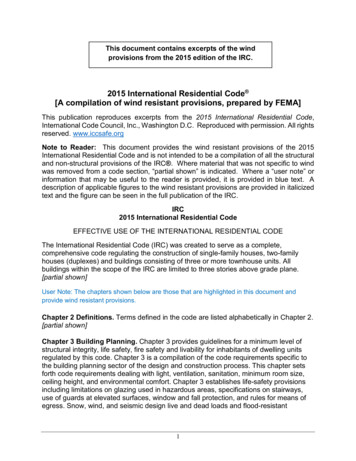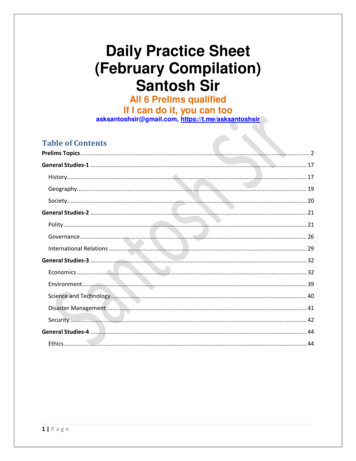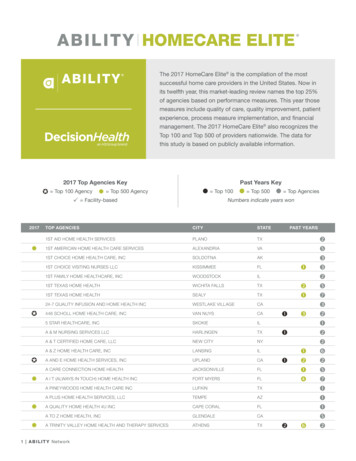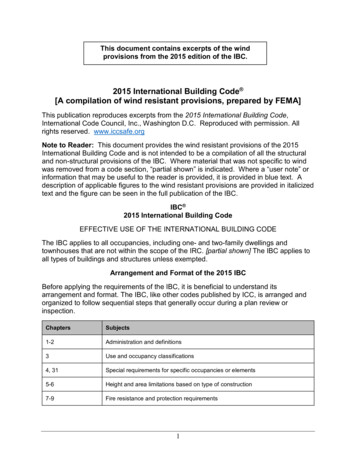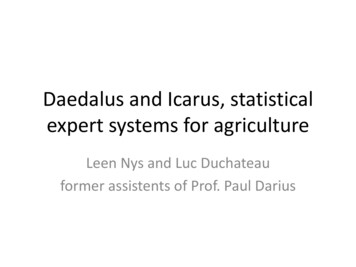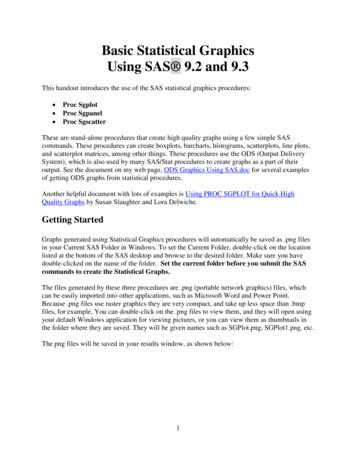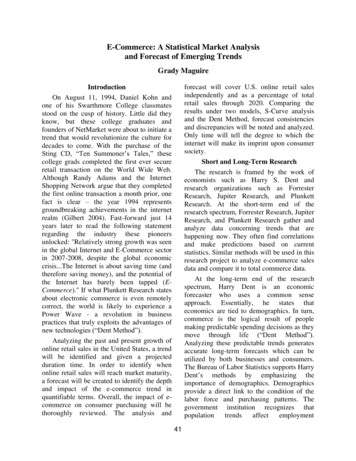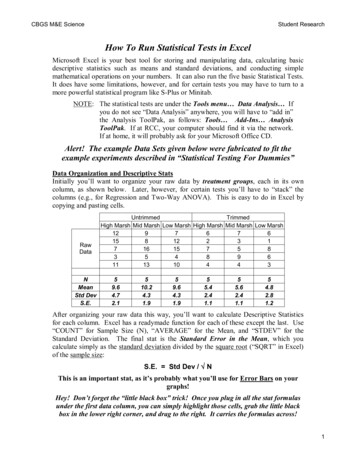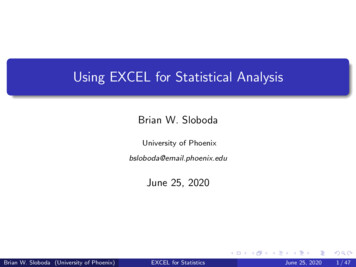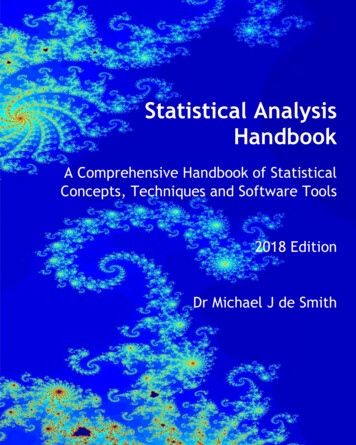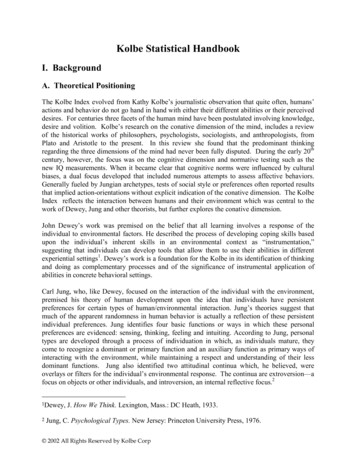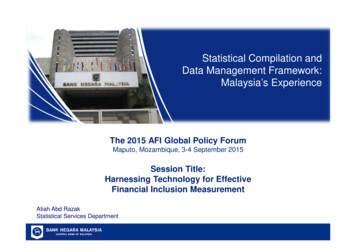
Transcription
Statistical Compilation andData Management Framework:Malaysia’s ExperienceThe 2015 AFI Global Policy ForumMaputo, Mozambique, 3-4 September 2015Session Title:Harnessing Technology for EffectiveFinancial Inclusion MeasurementAtiah Abd RazakStatistical Services Department
Outline of Presentation1. Statistical Compilation and Management Framework2. Financial Inclusion Data Collection3. Data Governance and Support Services2
Role of statistics supporting surveillance and policy formulationMonetary Policy& EconomicDevelopment1. Promote monetary stability and ensure availability of adequate credit tofinance economic activities2. Provide research support and advice on growth-related issues to theGovernmentInvestment &Operations1. Manage domestic liquidity and exchange rates2. Manage external reserves to safeguard its value3. Provide advice and assistance to the Government in the area of debt andfund .4.Promote and ensure financial stabilityProvide competitive environment for local financial industry to be resilientLead initiatives to enhance access to financingFormulate policies and strategies towards building and positioning Malaysiaas a premier integrated Islamic Financial Centre5. Enhance the financial capability of consumersDevelop, enhance and implement an effective surveillance framework to ensuresafety and soundness of financial institutions and to enforce sound practices inthemDevelop policies and strategies to promote reliable, secure and efficient clearing,settlement and payment systems in the country3
Statistical compilation frameworkStatistics CompiledData Management1. Banking Statistics1. Data Origination2. Insurance Statistics2. Data Quality andIntegrity3. Credit & Charge CardOperations4. DevelopmentFinancial InstitutionsStatistics5. External SectorStatistics6. MacroeconomicsStatistics3. Data Dissemination4. Data Integration5. Data ChangeManagement6. MetadataManagement7. Retention andArchiving7. Credit Reports4UsersInternal Departments1. Monetary and Economic2. Regulation3. Supervision4. Investment Managementand Foreign ExchangeAdministration5. Payment Systems6. Financial IntelligenceExternal1. International Organisations2. Department of StatisticsMalaysia3. Government Agencies4. Financial Institutions5. Public
Statistical information and interlinkagesExternal Sector Flowsand Stock1. Non-resident Counter PartyProfile Name of Non-residents Non-resident ID Institutional Sector Business Sector Relationship Non-residents2. Investment Information Type of Instruments Country Currency3. External Assets & LiabilitiesPosition Opening Position Transactions Valuation & OtherCharges Closing Position Investment IncomeDetails of Financial Assets and LiabilitiesCredit Information1. Securities Maturity FinancingConcept Collateral Lender Type/Instruments Rating Stock Issuance Date1. Application Details2. Loans Facility Sector Purpose State Maturity Country Currency FinancingConcept3. Deposits CustomerType State Maturity4. Assets/Liabilities Fund BusinessClassI. Financial Assets & Liabilities1. Equity2. Securities3. LoansIII. ExternalSector4. Deposits5. OthersIV. MacroeconomicsII. Credit Real Financial External FiscalEntity Profiles1. Name2. ID/Registration No.3. Nationality/Country ofOperation4. Resident/Non-Resident5. Corporate Status6. Industrial Sector52. Loan Details Approval Date/Limit Facility Type Purpose of Loan Financing Concept Repayment Term Interest/Rebate Rate Type of Pricing Maturity Date3. Account Position Outstanding Balance Months in Arrears Installments In Arrears Amount Undrawn Account Status Loan Sold to Secondary Market underSBBA Amount Disbursed Amount Repaid4. Provision Impaired Loan Tagging Month In Arrears Principal Outstanding Interest/Income Outstanding Other Charges Individual Impairment Provision Impaired Loan Written-back/Written-off5. Account Collateral6. Legal Action
Statistical submission and management leverage on ITCurrent systems are by subject areas and not fully integrated. All statistics areelectronically submitted and managed as follows:Reporting1.Financial Assets &Liabilities (aggregatedreporting by institutions)i.Submission and storage1.Bankingiii. PaymentsCredit (transactionalreporting by borrowers andaccounts)1.Statistical systemsdeveloped based onbusiness requirements tosupport submission,processing, storage anddissemination.2.Integrated storage and datamarts leverage on BusinessIntelligence (BI) tools, i.e.Cognos Impromptu andPowerplay, SAS, BusinessObjects and TM1 to facilitateease of data mining andretrieval.Integrated storage (2) forbanking andinsurance/Takaful.ii. Insurance/Takaful2.Individual systems (7) bybanking, insurance/Takafuland payments statistics.Technology2.Individual system (3) forcredit data and as creditbureau.Data mart (1) for analysisand surveillance.3.External Sector(transactional reporting byindividuals and institutions)3.Individual system (1) forexternal sector statistics foranalysis and surveillance.4.Macro-economics(secondary data fromnational statistics office)4.Data mart (1) for analysisand surveillance.Slide 206
Moving towards integrated solution Integrated Statistical System (ISS)ObjectiveA single platform for effective and efficient data management to meet theBank’s business needs and desired outcomesDeliverablesAn integrated statistical system with agile IT infrastructure for end-to-enddata management from data submission, storage to dissemination for allsubject areas- for full completion by 2018Benefits1.2.3.4.More efficient data management Bank-wideEasy and fast access to timely, credible and relevant dataReduced reporting burden by eliminating data duplicationEase of IT maintenance and support7
ISS Project Overview architecture and designData RepositoryLayerData Source LayerData ance/Reinsurance/TakafulCompaniesNew Statistical ReportingData StoreFinancial DataBankingOperational DataStore (ODS)DataIntegrationLayerData Dissemination LayerData Mart StoreReportingServicesCreditInsurance pecificStandard ReportingDevelopment FinanceIntermediariesAd hoc QueryData iesPayments SystemCreditStaging andIntegrationBankingComplianceCreditExternal SectorAnalytics (Mining)OthersInsuranceCard CompaniesOther Agencies& CorporationsDashboardEvent DrivenReportingNon orMacroeconomicExternal ReportingIndividualsDOSM, KWSP,PIDM, BURSA,etcCorporateProfileMacroeconomic88
ISS Implementation PhasesPhase 1Phase 2Phase 3(2011-2014)(2015-2017)(2016-2018)1. Standard Platform for Data Submission to BNM by All Reporting Entities Statistics on:Statistics on: Statistics on: External sector statistics Banking Institutions Insurance Companies,Takaful Operators and Macro-economic data (from Payment System OperatorsIntermediariesgovernment agencies) Devt Financial Institutions Credit2.End-to-end IT infrastructurefor all components of ISS2.Migration of external sectorand macroeconomic data3.Centralised data repositoryand migration of historicalbanking, payments anddevelopment finance data3.Statistical information portalfor external sector andmacroeconomic data4.5.Statistical information portalfor banking, payments anddevelopment finance data4.2.Migration of historicalinsurance, takaful,intermediaries and credit data3.Statistical information portalfor insurance, takaful,intermediaries, and creditdata4.Develop business continuityplan and set up recoveryenvironment5.Decommission of legacystatistical systemsInterfaces from/to legacystatistical systemsEnhancements and interfacesfrom/to legacy statisticalsystems9
Outline of Presentation1. Statistical Compilation and Management Framework2. Financial Inclusion Data Collection3. Data Governance and Support Services10
Financial inclusion data collection Malaysia’s experience1. Financial AccessSurvey2. Basic BankingProducts3. FinancialInclusion Survey BNM participates in the annual FAS surveyconducted by the IMF BNM surveys banking and development financialinstitutions on a half-yearly basis on the numberof basic savings account and basic currentaccounts opened by individuals and SMEs. BNM collects information on access to financing,deposit accounts and insurance products from alllicensed financial institutions on an annual basis(from Supply Side).11
Financial inclusion statistics (1)1. Sources and indicators of IMF Financial Access SurveyDepartmentUnitSourceData descriptionReporting entityJPSBankingFICPS/FISS- Number of Institutions*- Number of Branches*- Number of Deposit Accounts- Number of Loan Accountsof which: SME accountshousehold accounts- Outstanding Depositsof which: household accounts- Outstanding Loansof which: SME & household accountsCommercial,Islamic andInvestment BanksNumber of Borrowers (with followingcriteria): Only on balance sheet borrowers Exclude loans sold to third parties Borrowers of loans outstanding inCCRIS that is comparable to FISSCommercial,Islamic andInvestment Banks Insurancecorporations &Takaful operatorsSlides 22-23CreditCCRISSlide 24InsuranceICSS/TOSSSlides 25-26Number of insurance policy holdersNumber of insurance policies12
Financial inclusion statistics (2)Sources and indicators of IMF Financial Access Survey (cont’d)DepartmentData descriptionReporting entityUPPP (RSA)/JDSP Number of ATM NetworksCommercial and Islamic BanksJKPE Number of ATMsNumber of branchesNumber of loan accountsof which: IndividualsSMEsNumber of deposit accountsof which: IndividualsOutstanding Depositsof which: IndividualsOutstanding Loans - SMEsDFIs (BSN, Bank Rakyat & Agrobank) 2. Sources and indicators of Basic Banking ProductsDepartmentUnitSource/SystemData descriptionReporting entityJPSBankingSurvey responsecollected viaemail Number of basic savings accountand basic current accountsopened by individuals.13Banking anddevelopmentfinancialinstitutions
Financial inclusion statistics (3)3. Sources and indicators of Financial Inclusion Survey (from Supply Side)DepartmentUnitSource/SystemData descriptionReporting entityJPSCreditCCRIS All types of financing accountsmaintained by Malaysianindividuals, irrespective of age(e.g. loans)BankingSurvey responsesaved into CD All types of active depositaccounts maintained byMalaysian individuals,irrespective of age (e.g. savingsaccount, current account).InsuranceSurvey responsesaved into CD Life Insurance Policies/FamilyCertificates (Plans) andFinancing subscribed by theMalaysian Individuals,irrespective of age14 CommercialbanksIslamic nsInsurancecompaniesTakafuloperators
Financial inclusion statistics survey from Supply sideTypeDepositAccountsSourceBanking andDFI SurveysInformationCollectedStatistics1. FI CodeNo. ofcustomers is3. Date of birth calculatedleveraging Financial inclusion4. Financialon unique ID is measured as “%2. Customer ulOperatorsSurveysCCRISinclusiontype code5. State Codeof Branch6. Financialinclusiondate* Refer to adult population (age 15 years old)15of Customershaving access toat least one of thefinancial services”
Outline of Presentation1. Statistical Compilation and Management Framework2. Financial Inclusion Data Collection3. Data Governance and Support Services16
Enterprise data governance discipline in data managementQuality ccessibilityConfidentialityAuditabilityEnterprise Data GovernanceOrganisationPolicies & Procedures Oversight CommitteeRoles & ResponsibilitiesChange ManagementKnowledge & Learning Data Needs ManagementData Architecture ManagementMetadata ManagementReference and Master DataManagementData Quality ManagementData Privacy and SecurityManagementData Retention and ArchivalManagementData Integration InfrastructureLegislation17Standards MetadataReference CodesMaster DataTechnology
Comprehensive data quality assurance processDataProvider Comply with thereportingguidelinesprovided by BankNegara Malaysia Understandsystemfunctionalities andreportingrequirements Conduct internalvalidation toensure dataaccuracy andconsistency Rectify data errorsidentified orrejected bysystem and BankNegara MalaysiaSystemDataCompilerData QualityReview PanelUsers Develop validationrules insubmissionsystem Perform dataquality checks viamicro and macroanalysis Provideindependentassessment ondata quality Highlight outliersin data compiledduring analysisand research Perform datavalidation check Engage and trainreporting entitieson reportingrequirements Users are invitedto attend andparticipate Ensure data alignwith internationalreportingstandards (e.g.IFRS and BPM)and policyguidelines Generate dataprocessing andvalidation result Return data errorsto reportingentities Enhance systemto incorporateadditionalvalidation rules,where necessary Update reportingguidelines toenhance clarity onreportingrequirements18 Ensureconsistency ofdata with otherindicators andeconomic/financialdevelopments
Dissemination and communications1. Reports Standard reports Filterable by common dimensions View data at granular level based on access rights Users granted access to Business intelligence2. Analytical tools 3. Publicationstools such as Cognos Impromptu/ Powerplay,SAS, Business Objects and TM1 to facilitategeneration of data by different dimensionsAble to view to transactional details Statistics collected are published in: BNM’s periodic reports such as the Quarterly Bulletin and Annual ReportReports of international agencies such as IMF,BIS and World Bank19
Comprehensive support to stakeholders1. Classrooms and hands on training tousers Reporting requirements Data items and database structure System and business intelligen
Cognos Impromptu and Powerplay, SAS, Business Objects and TM1 to facilitate ease of data mining and retrieval. Submission and storage 1. Financial Assets & Liabilities (aggregated reporting by institutions) i. Banking ii. Insurance/Takaful iii. Payments 2. Credit (transactional reporting by borrowers and accounts) 3. External Sector (transactional reporting by individuals and institutions) 4 .
